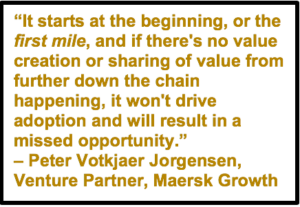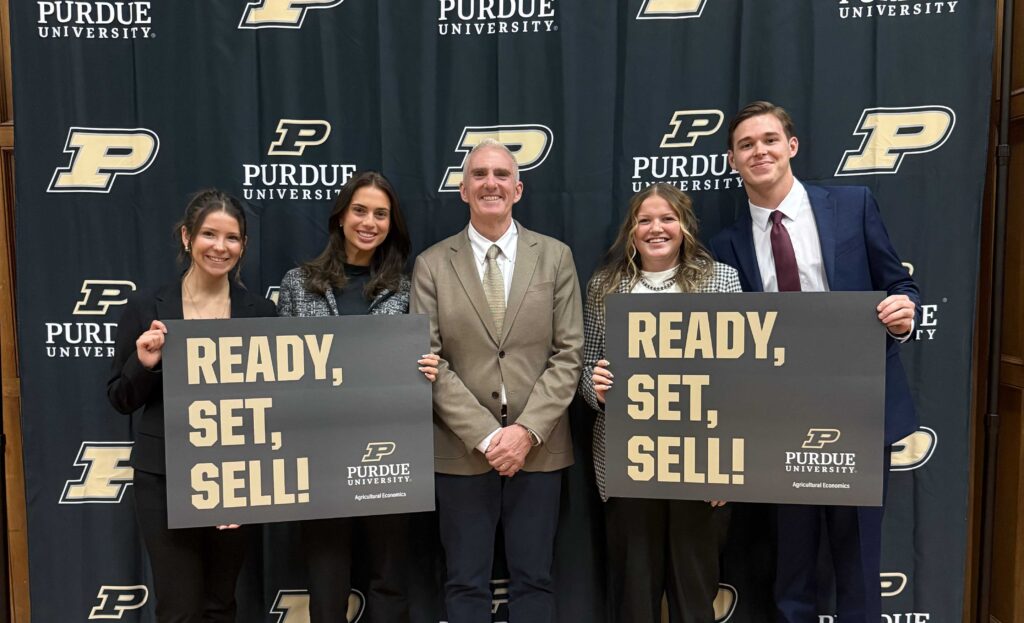As we navigate a world of constant advancement and disruption, could the phenomenon that is blockchain technology be the next innovation that could truly drive efficiencies—and much more—in the food supply chain?
Recently, the Purdue University Center for Food and Agricultural Business had the opportunity to interview Phil Harris, President and Co-Founder of ripe.io, Raja Ramachandran, CEO of ripe.io, and Peter Votkjaer Jorgensen, Venture Partner of Maersk Growth on the implications of blockchain technology for food and agribusinesses and the possibility of impact on current business practices.
What is the most exciting possibility that could result from blockchain technology adopted in the food industry?
Peter: The food industry—from farm to fork—has a big role to play in global challenges, whether it’s growing populations, shortage of natural resources, CO2 emissions, general health, etc. With current waste levels, we need to produce 70 percent more food to feed the global population in 2050. We want to reduce waste, but at the same time, producing more food will require more natural resources.
While we want/need to eat healthier, this requires transparency of what we consume. We want to reduce CO2 emissions, but we don’t really understand the link between what we consume and CO2 impact. There are many aspects and nuances and no simple way of going about them, but at the core of enabling more informed decisions, more impactful transformations and ultimately getting more out of less resources and food distributed to where it’s needed (before going to waste), digitization of the food system is essential. Blockchain offers exactly that—more transparency, trust and real-time decisions. A multitude of opportunities will emerge once data driven supply chain decisions are made based on digitization, and that’s truly an exciting outlook.
Phil & Raja:
- Reducing Food Waste: Annual food waste will reach 2.1 billion tons by 2030 (BCG 2018 Report).By tracking and tracing food items in real time, supply chain participants are alerted of incongruencies and can manage food safety, inventory and freshness to prevent food waste. ripe.io’s solution allows users to detect and communicate inefficiencies in fresh products and certify the information holds true on the blockchain system.
- Sustainability: Customers want information beyond the physical food product. Visibility into organic certification, animal welfare practices, soil quality, etc. backed by a blockchain ledger help assure consumers the information provided holds true and aligns with sustainability values. It also holds the industry accountable for more ethical and sustainable practices that provide a better future for generations to come.
- Locality: Consumers want more validation on the origin of the food they’re consuming. Due to disconnected communication systems, food supply chain stakeholders have challenges providing this information. Through ripe.io’s product (the Food Bundle—see details below), consumers are able to track the granular details of the origin of their food products and better support local agriculture. This also helps mollify the rural-urban divide by generating rural economies and connecting our communities through food.
What are the misperceptions about blockchain technology?
Phil & Raja: Blockchain is more than a system for Bitcoin/other cryptocurrencies, and many of its strongest benefits live outside a cryptocurrency use case. It is a tool to prevent insubordinate actions by supporting and holding participants accountable for providing honest information. It is only as strong as its participants and will not solve for extenuating human error.
Peter: There are technical aspects that can be better answered by others, but specific to the food system are two key observations:
- From some industry debates, consumers can be led to conclude that blockchain makes food safe. In reality, food is generally safe with or without blockchain. Blockchain can certainly trace a produce “instantly”, but you still need to know where to look. When an “outbreak” is detected, evidence is gathered and relevant parties are informed (including the public), but several days will pass. Only at the last step will you start tracing through blockchain.
- There’s a perception—resulting from the way industry players present the technology—that blockchain prevents fraud and guarantees provenance, e.g. that a particular produce is organic. However, the technology is only as strong as the accompanying protocols, checks and control procedures, and the people involved in the operation. This is of particular importance to understand, otherwise blockchain can “easily” be used to legitimize otherwise fraudulent produce/goods.
The technology—when applied and understood correctly—can transform the whole food system and benefit all players along the way. Therefore, it’s also important to recognize that it starts at the beginning, or the “first mile”, and if there’s no value creation or sharing of value from further down the chain happening, it won’t drive adoption and will result in a missed opportunity.
What value does blockchain technology bring to ripe.io and the Food Bundle approach?
Phil & Raja: The Food Bundle is the digital picture of the physical food product that can utilize the full potential of blockchain technology. Given how blockchain is a system developed to create trust around records and activities of a supply chain surrounding the lifecycle of a product, the Food Bundle lives as a map on the blockchain to show the aggregation of food inputs from a multi-faceted industry. It utilizes blockchain’s features of being a visible tool to democratize information, provide data ownership attribution and connect data sources into a single system. By providing circular insight through a blockchain into the evolution of a food product, the Food Bundle is a digital representation of the physical product and is formed as a single source of truth for telling the food story and evolving how we interact with our food system.
Peter: Maersk is on a mission to become the leading global logistics company, and the key to delivering effective and integrated end-2-end solutions is digitization. Having a +30 percent global market share of all refrigerated container transport, the food supply chain therefore carries great interest and priority for Maersk. We saw a perfect fit between what we want to achieve and ripe.io’s Food Bundle. It is critical to have transparency, reliability, analytics and the ability to make data-driven supply chain decisions. ripe.io’s market and technology comprehension and impeccable team made it an easy decision for us to partner.
Beyond the Blog
Learn more from Peter and Phil at the Purdue Food and Agribusiness Executive Summit October 1-3, 2019. This Summit will provide senior level leaders the opportunity to network with peers and engage in a series of case studies, company discussions and special topics based on disruption happening across the food and agribusiness industry. Prepare yourself for the conversations to come in your board room by applying to take part in the 2019 Summit.
If the Summit isn’t for you, check out our other upcoming professional development workshops. Click here for more information and find a program right for you.
:



